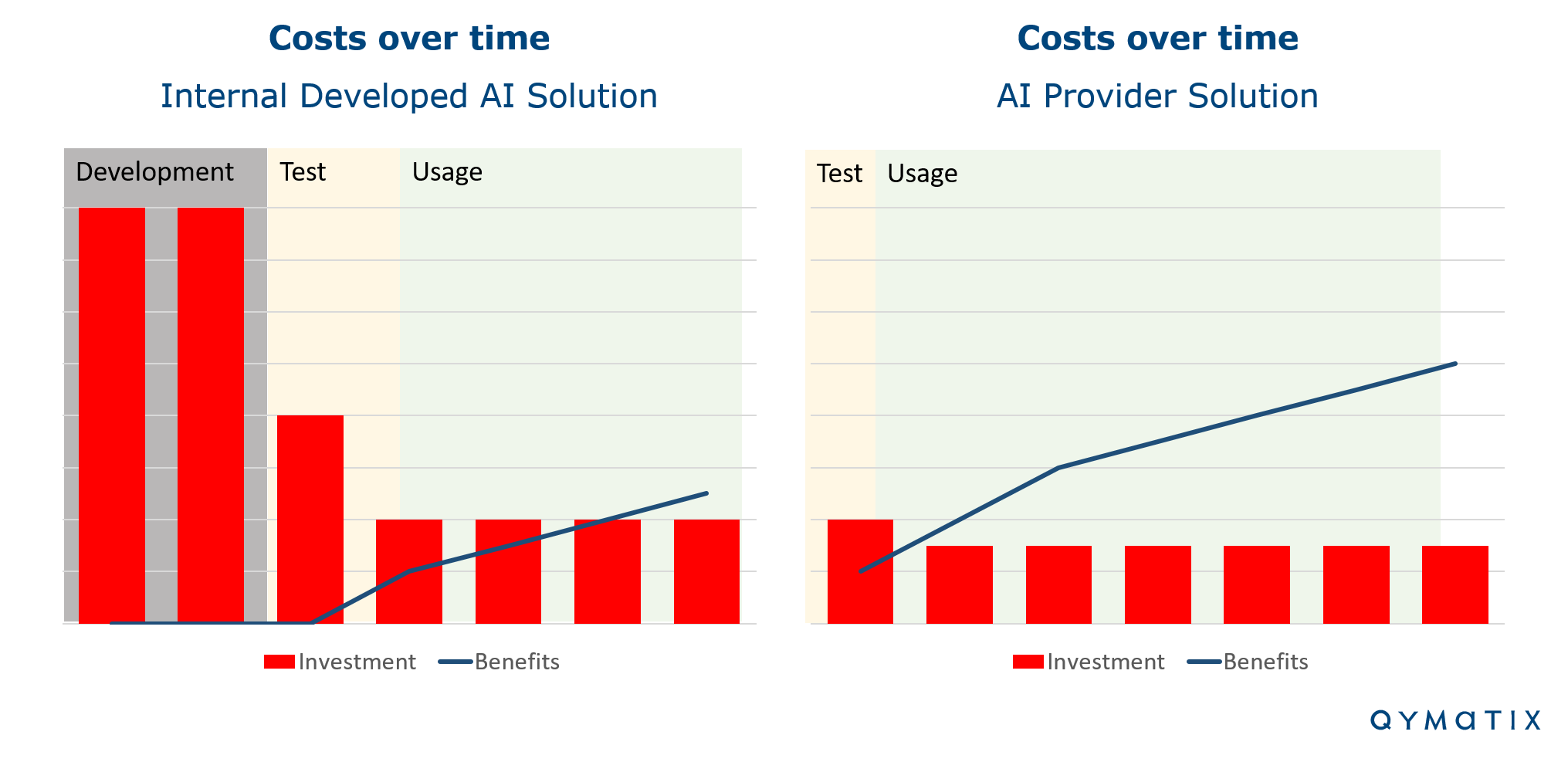Artificial Intelligence Software Development: The True Costs.

Please enter your Email address
The question is no longer “if” a B2B company will implement artificial intelligence (AI), but “how”.
AI tools enable more efficient work in many areas. B2B sales is no exception. Artificial Intelligence Sales Software saves time, stress and costs, while improving customer lifetime value and experience.
Companies that do NOT adopt AI-powered tools will be significantly more inefficient than their competitors and will be left behind.
Since you are here, my guess is that your already know that. For that reason, let’s focus on the “make or buy” decision and park the benefits of AI-powered software in another article.
For example, until about a year or two ago, the main topic in our customer inquiries and initial presentations was “what does AI mean for sales and how does it work.”
Now, especially with large mid-sized companies and corporations, the focus shifted. The main topic of our conversations nowadays goes about the “why should we buy your off-the-shelf software, if we could develop AI ourselves? ”.
Of course, you cannot answer this question across the board and for all AI applications. This post will discuss the topic of “make or buy” with a focus on AI-based predictive sales software.
Rule of thumb: AI as core business – make. AI to support – buy.
To apply this rule of thumb, you should ask the right questions: What strategic problem do you want to solve? Or put another way: What is the main goal to achieve with the AI software?
Let us be straight: if you want to make an AI application your core business by strategically taking a new direction – there’s not much to think about. You should develop the AI technology in-house. Just like with new business model innovations. That is the only way the company is guaranteed intellectual property for the application. And who wants to be dependent on a vendor for their core business?
Let’s move on to the “buy” side now. For supporting AI tools that facilitate/improve routine activities, it is not advisable to develop them yourself.
That is true for areas outside your core business, such as sales, HR, customer service, finance, and accounting. When was the last time you devolved your own CRM? Have you not heard of Salesforce?
A predictive sales software for your B2B sales team will most likely fall into the category business supporting application.
Such an AI application aims to predict customer behaviour as accurately as possible based on historical data. It is an easy-to-implement application that achieves quick wins.
That is where you should strongly consider “buy”. Why? It’s a cost-benefit calculation.
And the actual “make”-costs is often highly underestimated.
Do you know the true cost?
We stick with an AI application to support routine activities and deliver immediate added value.
With in-house development, you might save on licensing costs to the vendor and initial implementation costs. But what do you need to deliver? What is the real Total-Cost-of-Ownership?
First, the obvious: developing an AI application takes time, money, and skilled people. Many big SMEs think: “no big deal – we’ve got plenty of them. “.
We are happy for you! Now weight the cost-benefit again. I am sure you also have a limit of money, time, and resources for a “merely” supporting tool.
Anyone who knows a bit about AI and especially machine learning knows that even standard vendors rely on open-source models (among others) for their algorithms.
That feigns “false simplicity.” Even with open-source models, the creation up to the application of artificial intelligence costs hundreds of thousands up to millions of Euros. Not to mention the customization and optimization of the models.
It takes months to train a machine learning algorithm satisfactorily. To solve the tasks, it is supposed to solve. It also takes huge amounts of data, not always at your disposal.
Accordingly, you have very high initial development costs for something that already exists on the market, specialized and ready to use.
“Okay. High initial costs are well known. But once we have developed the application, there are no more costs – unlike the licensing costs of a vendor,” argue many “make” proponents.
Unfortunately, this is only 50% correct. Yes, there are license costs for the vendor – quite clearly. But no, you do not stop paying after your development! Your software also needs to be maintained, serviced, and continuously optimized. You need extra employees to take care of this.
What about the benefits? With in-house development, you have a very high-cost block, especially at the beginning, and no revenue from using the AI.
On the contrary, purchased software is ready to use after a few days and delivers immediate value. The chart nicely shows cost-benefit over time.

This chart also only applies if the AI project is successful. What about risks?
Factors: risk and safety.
According to the Project Management Institute 2017 study, 14% of all internal software projects fail, 31% miss targets, and 49% overrun deadlines.
As mentioned above, AI projects require very specialized and skilled staff. These employees are not available for other projects during that time. So, think about opportunity risks as well. Do you also need these employees for your core business so that it might suffer?
You should also consider attrition in your IT department. If one of the developing or trained employees leaves the company, delays and costs for new onboarding occur again.
Why do I describe the risks of in-house development in such detail? Because they often are greatly underestimated in practice. Moreover, they are particularly underestimated by your IT developers.
Hopefully, we can all agree that there is no such thing as 100% certainty in new investments and projects – independent of “make” or “buy”.
However, remember that an AI vendor deals with these issues routinely, therefore gaining tons of experience on these areas.
Many software providers have pre-trained algorithms and AI experts.
Furthermore, the best AI solution providers offer qualified user training – AI tool is only as good as its users.
CALCULATE NOW THE ROI OF QYMATIX PREDICTIVE SALES SOFTWARE
Artificial Intelligence Software: the truth about development – Conclusion.
When making a “make or buy” decision, do not make a naive fallacy and consider all the essential factors:
The problem, the goal. The true cost. The risks.
The rule of thumb “AI as a core business – make. AI to support – buy.” provides good guidance. Add the availability of resources and the maturity of the AI solution to your equation.
For example, AI-powered predictive sales analytics software is ready to go and adds immediate value from implementation.
So why should you incur the costs and risks of building such an application yourself, even though it “only” serves as a support and is not part of your core business?
I WANT PREDICTIVE ANALYTICS FOR B2B SALES.
Further Read:
Stefan Ramershoven (2021): KI programmieren oder kaufen? Ed. Computerwoche- (German language)
KI Software – selber entwickeln oder einkaufen? Ed. Paraboost. (German language)